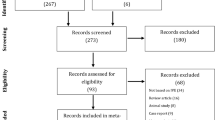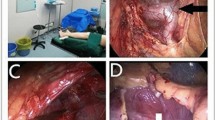Abstract
Microsurgical denervation of the spermatic cord (MDSC) is a treatment option in patients with chronic orchialgia. This procedure requires precise care to avoid any thermal damage to crucial adjacent tissues (arteries, veins, and lymphatics). Monopolar electrocautery is the standard ligation energy source, but may cause extensive collateral damage to the tissues. However, CO2 laser is known to produce a very predictable tissue penetration and minimal collateral spread. The goal of this study was to compare the extent of collateral thermal damage in both monopolar electrocautery and CO2 laser ablation in the spermatic cord during a robotic assisted MDSC (RMDSC) procedure as well as the feasibility for utilizing the flexible fiber-optic CO2 laser probe after “RMDSC” procedure. RMDSC was performed using standard monopolar electrocautery on the spermatic cord of one side of a fresh human male cadaver (randomly selected) and then compared to RMDSC using the CO2 laser on the contralateral spermatic cord. Nine histological cross-sections from each cord were measured for depth of collateral thermal/cautery injury. The mean collateral thermal injury with CO2 laser was 0.17 ± 0.031 mm (range: 0.15–0.25 mm), and with standard electrocautery 0.72 ± 0.046 mm (range: 0.60–0.75 mm). CO2 laser resulted significantly less collateral thermal injury than standard electrocautery (p < 0.0001). The CO2 laser probe was easy to manipulate with the Black Diamond micro-forceps (Intuitive Surgical, CA) and allowed for convenient tissue plane dissection. Human cadaveric targeted RMDSC using a flexible CO2 laser energy results in significantly decreased collateral thermal injury compared to standard monopolar electrocautery. These initial findings suggest potential advantages of the CO2 laser over traditional monopolar cautery in cases requiring minimal collateral tissue damage. Future studies are needed to assess its clinical potential in microsurgery.
This is a preview of subscription content, access via your institution
Access options
Subscribe to this journal
Receive 8 print issues and online access
$259.00 per year
only $32.38 per issue
Buy this article
- Purchase on Springer Link
- Instant access to full article PDF
Prices may be subject to local taxes which are calculated during checkout



Similar content being viewed by others
References
Davis BE, Noble MJ, Weigel JW, Foret JD, Mebust WK. Analysis and management of chronic testicular pain. J Urol. 1990;143:936–9.
Sibert L, Safsaf A, Rigaud J, Delavierre D, Labat JJ. Impact of chronic pelvic pain on sexual functions and fertility. Prog Urol. 2010;20:917–21.
Oliveira RG, Camara C, Alves Jde M, Coelho RF, Lucon AM, Srougi M. Microsurgical testicular denervation for the treatment of chronic testicular pain initial results. Clinics. 2009;64:393–6.
Strom KH, Levine LA. Microsurgical denervation of the spermatic cord for chronic orchialgia: long-term results from a single center. J Urol. 2008;180:949–53.
Baggish MS, Tucker RD. Tissue actions of bipolar scissors compared with monopolar devices. Fertil Steril. 1995;63:422–6.
Tulikangas PK, Smith T, Falcone T, Boparai N, Walters MD. Gross and histologic characteristics of laparoscopic injuries with four different energy sources. Fertil Steril. 2001;75:806–10.
Ryan RW, Spetzler RF, Preul MC. Aura of technology and the cutting edge: a history of lasers in neurosurgery. Neurosurg Focus 2009;27:E6.
Parekattil SJ, Gudeloglu A, Brahmbhatt JV, Priola KB, Vieweg J, Allan RW. Trifecta nerve complex: potential anatomical basis for microsurgical denervation of the spermatic cord for chronic orchialgia. J Urol. 2013;190:265–70.
Hanby DF, Gremillion G, Zieske AW, Loehn B, Whitworth R, Wolf T, et al. Harmonic scalpel versus flexible CO2 laser for tongue resection: a histopathological analysis of thermal damage in human cadavers. World J Surg Oncol. 2011;9:83.
Cheetham PJ, Truesdale MD, Lee DJ, Landman JM, Badani KK. Use of a flexible carbon dioxide laser fiber for precise dissection of the neurovascular bundle during robot-assisted laparoscopic prostatectomy. J Endourol/Endourol Soc. 2010;24:1091–6.
Barton SE, Garguilo AR. Robot-assisted laparoscopic myomectomy and adenomyomectomy with a flexible CO2 laser device. J Robot Surg. 2013;7:157–62.
Calixte N, Brahmbhatt J, Parekattil S. Chronic testicular and groin pain: pathway to relief. Curr Urol Rep. 2017;18:83.
Gudeloglu A, Brahmbhatt JV, Parekattil SJ. Robotic microsurgery in male infertility and urology—taking robotics to the next level. Transl Androl Urol. 2014;3:102–12.
Devaiah AK, Shapshay SM, Desai U, Shapira G, Weisberg O, Torres DS, et al. Surgical utility of a new carbon dioxide laser fiber: functional and histological study. Laryngoscope. 2005;115:1463–8.
Anandasabapathy S, Maru D, Klumpp S, Uthamanthil R, Borne A, Bhutani MS. Novel endoscopic application of a new flexible-fiber CO2 laser for esophageal mucosal ablation in a porcine model. Endoscopy. 2009;41:138–42.
Ramasamy R, Sterling J, Li PS, Robinson BD, Parekattil S, Chen J, et al. Multiphoton imaging and laser ablation of rodent spermatic cord nerves: potential treatment for patients with chronic orchialgia. J Urol. 2012;187:733–8.
Funding
Funding for the fresh human cadaver and instrumentation was provided by OmniGuide, Inc. All authors have no disclosures
Author information
Authors and Affiliations
Corresponding author
Ethics declarations
Conflict of interest
The authors declare that they have no conflict of interest.
Additional information
Publisher’s note Springer Nature remains neutral with regard to jurisdictional claims in published maps and institutional affiliations.
Rights and permissions
About this article
Cite this article
Gudeloglu, A., Kattoor, A.J., Brahmbhatt, J. et al. Prospective control trial: flexible CO2 laser vs. monopolar electrocautery for robotic microsurgical denervation of the spermatic cord. Int J Impot Res 32, 623–627 (2020). https://doi.org/10.1038/s41443-020-00352-0
Received:
Revised:
Accepted:
Published:
Issue Date:
DOI: https://doi.org/10.1038/s41443-020-00352-0
This article is cited by
-
Preclinical optimization of a diode laser-based clamp-free partial nephrectomy in a large animal model
Scientific Reports (2023)



